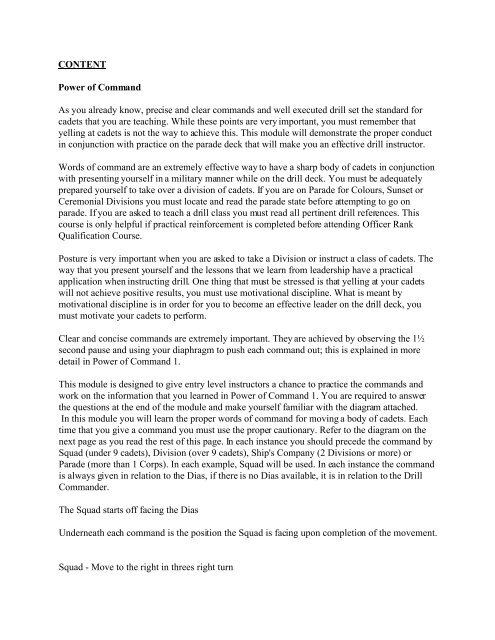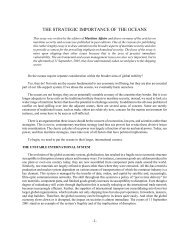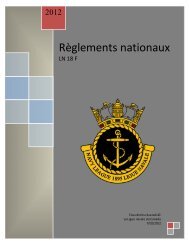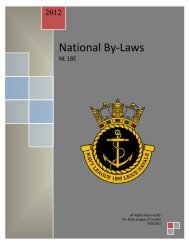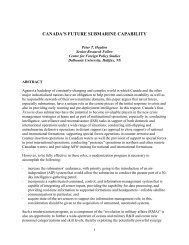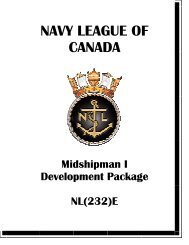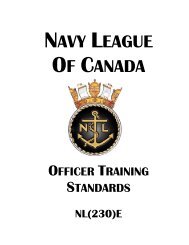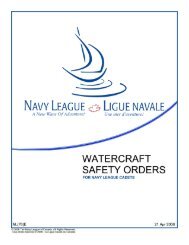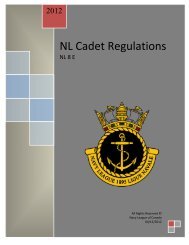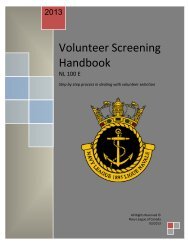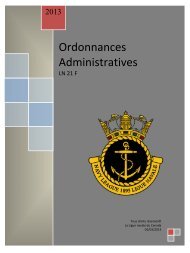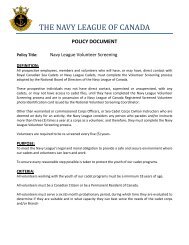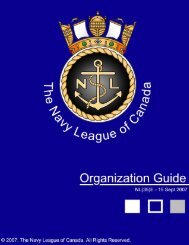Power of Command II - The Navy League of Canada
Power of Command II - The Navy League of Canada
Power of Command II - The Navy League of Canada
You also want an ePaper? Increase the reach of your titles
YUMPU automatically turns print PDFs into web optimized ePapers that Google loves.
CONTENT<strong>Power</strong> <strong>of</strong> <strong>Command</strong>As you already know, precise and clear commands and well executed drill set the standard forcadets that you are teaching. While these points are very important, you must remember thatyelling at cadets is not the way to achieve this. This module will demonstrate the proper conductin conjunction with practice on the parade deck that will make you an effective drill instructor.Words <strong>of</strong> command are an extremely effective way to have a sharp body <strong>of</strong> cadets in conjunctionwith presenting yourself in a military manner while on the drill deck. You must be adequatelyprepared yourself to take over a division <strong>of</strong> cadets. If you are on Parade for Colours, Sunset orCeremonial Divisions you must locate and read the parade state before attempting to go onparade. If you are asked to teach a drill class you must read all pertinent drill references. Thiscourse is only helpful if practical reinforcement is completed before attending Officer RankQualification Course.Posture is very important when you are asked to take a Division or instruct a class <strong>of</strong> cadets. <strong>The</strong>way that you present yourself and the lessons that we learn from leadership have a practicalapplication when instructing drill. One thing that must be stressed is that yelling at your cadetswill not achieve positive results, you must use motivational discipline. What is meant bymotivational discipline is in order for you to become an effective leader on the drill deck, youmust motivate your cadets to perform.Clear and concise commands are extremely important. <strong>The</strong>y are achieved by observing the 1½second pause and using your diaphragm to push each command out; this is explained in moredetail in <strong>Power</strong> <strong>of</strong> <strong>Command</strong> 1.This module is designed to give entry level instructors a chance to practice the commands andwork on the information that you learned in <strong>Power</strong> <strong>of</strong> <strong>Command</strong> 1. You are required to answerthe questions at the end <strong>of</strong> the module and make yourself familiar with the diagram attached.In this module you will learn the proper words <strong>of</strong> command for moving a body <strong>of</strong> cadets. Eachtime that you give a command you must use the proper cautionary. Refer to the diagram on thenext page as you read the rest <strong>of</strong> this page. In each instance you should precede the command bySquad (under 9 cadets), Division (over 9 cadets), Ship's Company (2 Divisions or more) orParade (more than 1 Corps). In each example, Squad will be used. In each instance the commandis always given in relation to the Dias, if there is no Dias available, it is in relation to the Drill<strong>Command</strong>er.<strong>The</strong> Squad starts <strong>of</strong>f facing the DiasUnderneath each command is the position the Squad is facing upon completion <strong>of</strong> the movement.Squad - Move to the right in threes right turn


